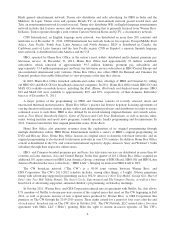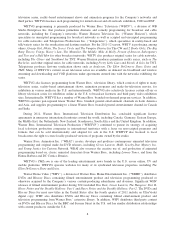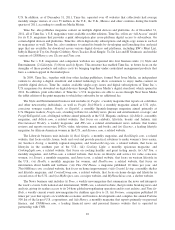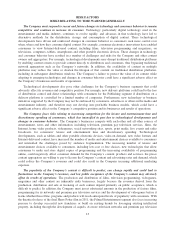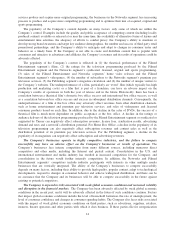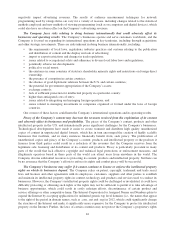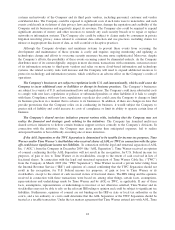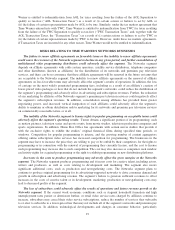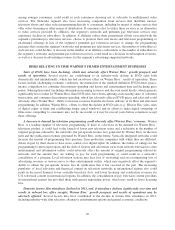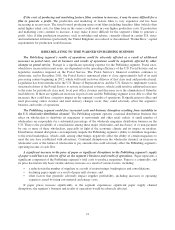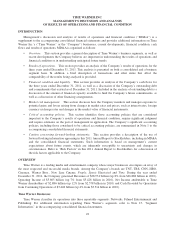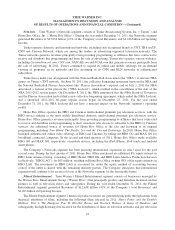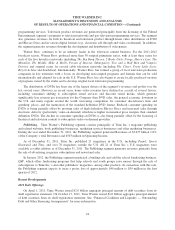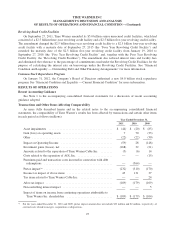Time Magazine 2011 Annual Report Download - page 29
Download and view the complete annual report
Please find page 29 of the 2011 Time Magazine annual report below. You can navigate through the pages in the report by either clicking on the pages listed below, or by using the keyword search tool below to find specific information within the annual report.under bankruptcy laws or otherwise experience negative effects on their businesses due to volatile or weak global
economic conditions, it could reduce the number of outlets for the Company’s DVD, Blu-ray Disc and magazine
products and otherwise negatively affect the Company’s businesses or operating results. Certain of the
Company’s operations are conducted in foreign currencies, and the value of these currencies fluctuates relative to
the U.S. dollar. As a result, the Company is exposed to exchange rate fluctuations, which in the past have had,
and in the future could have, an adverse effect on its results of operations in a given period. The foregoing risks
could increase significantly if one or more countries in the European Monetary Union stop recognizing the Euro
and instead issue national currencies, if there is a break-up of the European Monetary Union or a departure of one
or more countries from the Union. Any such developments in Europe could also adversely affect consumer
confidence and potentially increase the costs of goods and services in some countries, which would adversely
affect the Company’s businesses.
Increased volatility and disruptions in the financial markets also could make it more difficult and more
expensive for the Company to refinance outstanding indebtedness and obtain financing. In addition, the adoption
of new statutes and regulations, the implementation of recently enacted laws or new interpretations or the
enforcement of older laws and regulations applicable to the financial markets or the financial services industry
could result in a reduction in the amount of available credit or an increase in the cost of credit. Disruptions in the
financial markets can also adversely affect the Company’s lenders, insurers, customers and counterparties,
including vendors, retailers and film co-financing partners. For instance, the inability of the Company’s
counterparties to obtain capital on acceptable terms could impair their ability to perform under their agreements
with the Company and lead to various negative effects on the Company, including business disruption, decreased
revenues, increases in bad debt expenses and, in the case of film co-financing partners, greater risk with respect
to the performance of the Company’s films.
A decline in advertising expenditures or changes in advertising market conditions or other factors that
adversely impact advertising could cause the Company’s revenues and operating results to decline. The
Company derives substantial revenues from the sale of advertising, and a decrease in advertising expenditures
overall or reduced demand for the Company’s offerings could lead to a reduction in the amount of advertising
companies are willing to purchase from the Company and the price at which they purchase it. Expenditures by
advertisers tend to be cyclical, reflecting general economic conditions, as well as budgeting and buying patterns.
If the economic prospects of advertisers worsen or the current economic conditions persist or worsen, such
conditions could alter current or prospective advertisers’ spending priorities. For example, corporate marketing
cutbacks due to weak economic conditions could result in upfront advertising purchases being cancelled.
Declines in consumer spending due to weak economic conditions could also indirectly negatively impact the
Company’s advertising revenues by causing downward pricing pressure on advertising because advertisers may
not perceive as much value from advertising if consumers are purchasing fewer of their products or services.
Other factors in addition to weak economic conditions could adversely affect advertising expenditures.
Advertising sales and rates are dependent upon audience size, and advertisers’ willingness to purchase
advertising from the Company may be adversely affected by a decline in audience ratings at the Networks
segment or a decline in circulation, magazine readership or average monthly unique visitors at the Publishing
segment. If audience levels decline significantly, the Networks segment’s networks generally will be required to
provide additional advertising units to advertisers to reach agreed upon audience thresholds. This may result in
the networks having less inventory available to sell to other advertisers or to use to promote their own
programming. Advertising expenditures also could be negatively affected by other factors, such as shifting
societal norms, pressure from public interest groups and changes in laws and regulations. In addition, natural
disasters (including extreme weather), acts of terrorism, political uncertainty or hostilities could lead to a
reduction in advertising expenditures as a result of factors including uninterrupted news coverage and economic
uncertainty. Further, technological developments are increasing the number of media and entertainment choices
available to consumers and may cause changes in consumer behavior that could negatively affect the
attractiveness of the Company’s offerings to advertisers. Advertising sales and rates are also dependent on
audience measurement and they could be negatively affected by changes in audience measurement
methodologies. For example, with the advent of tablet editions of magazines, there could be shifts in how
consumers interact with magazines and how the audience for tablet editions of magazines is measured that could
15



